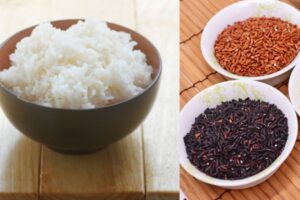purple rice is a nutritious choice! Rich in antioxidants, especially anthocyanins that give it its vibrant color, this rice variety can help fight inflammation and protect against chronic diseases. It’s also high in fiber, aiding digestion and promoting a feeling of fullness, which can be beneficial for weight management. Purple rice provides essential minerals like iron and magnesium, supporting overall health. Incorporating purple rice into your diet is a tasty way to boost your nutritional intake while enjoying a colorful and healthful meal.
What is Purple Rice?

Purple rice, also known as black rice or forbidden rice, is a whole grain with a rich, dark purple hue due to its high anthocyanin content. Originating from ancient China, it was once reserved for royalty because of its nutritional value and rarity. This rice is not only visually appealing but also packed with health benefits, including antioxidants, fiber, and essential minerals. Its slightly nutty flavor and chewy texture make it a versatile addition to various dishes, from salads to desserts, providing both taste and nutrition.
Nutrition in Purple rice
Rich in Antioxidants
Purple rice is packed with antioxidants, especially anthocyanins, which give it its distinctive color. Anthocyanins are powerful compounds that help neutralize harmful free radicals in the body. This can reduce oxidative stress and inflammation, supporting overall health and potentially lowering the risk of chronic diseases.
High in Fiber
This vibrant rice is also an excellent source of dietary fiber. Fiber plays a crucial role in digestion by helping to regulate bowel movements and prevent constipation. Additionally, it supports heart health by helping to manage cholesterol levels and stabilizing blood sugar levels.
Essential Vitamins and Minerals
Purple rice is loaded with essential vitamins and minerals. It contains key nutrients such as iron, magnesium, and zinc. Iron is vital for oxygen transport in the blood, magnesium supports muscle and nerve function, and zinc is important for immune health. Together, these nutrients contribute to maintaining a balanced and healthy diet.
Health Benefits of Purple Rice

Improves Heart Health
Purple rice is rich in antioxidants and fiber, which are great for your heart. The antioxidants, especially anthocyanins, help reduce inflammation and lower the risk of heart disease. Fiber helps manage cholesterol levels, keeping your arteries clear and improving overall cardiovascular health.
Supports Weight Loss
If you’re looking to shed some pounds, purple rice can help. It’s low in calories but high in fiber, which keeps you feeling full for longer. This helps reduce overall calorie intake and prevents overeating, making weight management easier and healthier.
Enhances Eye Health
Purple rice is good for your eyes too! It contains vitamin A and powerful antioxidants that protect your vision. These nutrients help prevent eye-related issues like cataracts and macular degeneration, keeping your eyes healthy and your vision sharp.
Boosts Immune System
The nutrients in purple rice, including vitamins, minerals, and antioxidants, strengthen your immune system. These components work together to protect your body against infections and diseases, ensuring you stay healthy and resilient. Adding purple rice to your diet is a delicious way to support your immune health.
How does purple rice compare to white rice?

Purple rice is much healthier than white rice. Here’s why:
Purple rice keeps its outer layer, which is full of fiber, vitamins, and minerals, while white rice has this layer removed. This makes purple rice a better choice for nutrition.
One of the big benefits of purple rice is its antioxidants. These help fight inflammation and protect against diseases. White rice doesn’t have these antioxidants, so it’s less beneficial for your health.
Purple rice also has more fiber, which helps with digestion and keeps you feeling full longer. This can help with weight management. In contrast, white rice has less fiber and can cause your blood sugar to spike more quickly.
Taste-wise, purple rice has a nutty flavor and a chewy texture, which can make your meals more interesting. White rice is softer and has a milder taste, cooking faster and blending easily with many dishes.
In short, while white rice is quick and neutral in taste, purple rice is a healthier and more flavorful option, offering more nutrients and health benefits. Choosing purple rice can be a simple way to boost your overall diet.
How to Cook purple rice?
Step-by-Step Cooking Instructions
Cooking purple rice is simple and straightforward. Start by rinsing one cup of purple rice under cold water to remove any excess starch. In a pot, combine the rinsed rice with two cups of water or broth for extra flavor. Bring the mixture to a boil, then reduce the heat to low and cover the pot. Let it simmer for about 30-35 minutes until the rice is tender and the liquid is absorbed. Once cooked, fluff the rice with a fork and let it sit covered for a few more minutes before serving.
Cooking Tips and Tricks
To achieve the perfect texture and flavor, here are a few tips:
- Soak the Rice: Soaking the rice for 30 minutes before cooking can help it cook more evenly and enhance its texture.
- Use the Right Ratio: Stick to the 1:2 ratio of rice to liquid for the best results. Adjust the water if you prefer softer or firmer rice.
- Flavor Boosters: For extra taste, cook the rice in vegetable or chicken broth instead of water. Adding a pinch of salt can also enhance the flavor.
- Rest Time: After cooking, let the rice sit covered for about 5-10 minutes. This resting time helps improve the texture and makes it fluffier.
Delicious Recipes using purple rice

1. Purple Rice Salad
For a refreshing and nutritious purple rice salad, start by cooking one cup of purple rice according to the package instructions and let it cool. In a large bowl, combine the cooled rice with diced bell peppers, cherry tomatoes, cucumbers, and red onions. Add chopped fresh herbs like cilantro or parsley for extra flavor. Toss everything with a simple vinaigrette made from olive oil, lemon juice, salt, and pepper. This vibrant salad is not only tasty but also packed with antioxidants and fiber, making it a great addition to any meal.
2. Purple Rice Pudding
Purple rice pudding is a healthy dessert that’s easy to make. Cook one cup of purple rice in two cups of coconut milk until the rice is tender and the mixture thickens. Sweeten it with honey or maple syrup to taste. Add a teaspoon of vanilla extract and a pinch of salt for extra flavor. Serve the pudding warm or chilled, topped with fresh fruits like mango or berries. This creamy, delicious pudding satisfies your sweet tooth while providing essential nutrients.
3. Purple Rice Bowl
A purple rice bowl is a versatile meal prep option. Start with a base of cooked purple rice. Add your choice of protein like grilled chicken, tofu, or shrimp. Top with a variety of vegetables such as avocado, spinach, and roasted sweet potatoes. Drizzle with your favorite sauce, like a tangy tahini dressing or spicy sriracha. This colorful and balanced bowl is perfect for lunch or dinner, offering a mix of flavors and nutrients in every bite.
FAQs ( read more)
1. Is purple rice gluten-free?
Ans- Yes, purple rice is naturally gluten-free. It’s a great option for those with gluten sensitivity or celiac disease.
2. Can I use purple rice in any recipe that calls for white rice?
Ans- Yes, you can substitute purple rice for white rice in most recipes. However, keep in mind that purple rice has a distinct nutty flavor and a chewier texture, which might slightly alter the dish’s taste and texture.
3. What is the shelf life of purple rice?
Ans- Purple rice typically has a shelf life of 6-12 months when stored in an airtight container in a cool, dry place. For the best quality, use it within this period.
4. How is purple rice different from black rice?
Ans- Purple rice and black rice are similar but not identical. Both are varieties of heirloom rice with high anthocyanin content, giving them their dark color. Purple rice has a lighter hue compared to black rice and may have a slightly different flavor and texture.
5. What are the health benefits of purple rice?
Ans- Purple rice is rich in antioxidants, particularly anthocyanins, which can help combat oxidative stress and inflammation. It’s also high in fiber, vitamins, and minerals, which contribute to overall health and well-being.
6. How should I cook purple rice?
Ans- To cook purple rice, rinse it thoroughly before cooking. Use a ratio of 1 cup rice to 2 cups water. Bring the water to a boil, then reduce to a simmer, cover, and cook for about 30-40 minutes until tender. Allow it to rest for 10 minutes before serving.
7. Can purple rice be used for desserts?
Ans- Yes, purple rice can be used in desserts. It is often used in Asian cuisine for making sweet rice dishes, puddings, and cakes due to its unique flavor and color.
8. Where can I buy purple rice?
Ans- Purple rice can be found in specialty grocery stores, Asian markets, and online. It’s often available in health food stores and supermarkets that carry a variety of rice options.
Conclusion
Purple rice is a powerhouse of nutrition. It’s rich in antioxidants, particularly anthocyanins, which help fight inflammation and protect against chronic diseases. High in fiber, it aids digestion, helps control blood sugar levels, and keeps you feeling full longer, supporting weight management. Purple rice also contains essential vitamins and minerals that benefit heart health, eye health, and immune function. Its unique nutty flavor and chewy texture make it a delightful addition to any meal.

